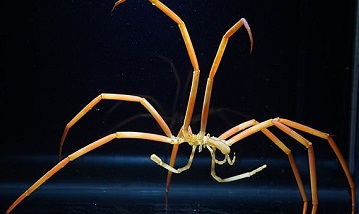Meet the monstrous giant sea spider that grows legs like ‘SWISS CHEESE’ that help it breathe in warming waters
Nightmarish giant sea spiders breathe through holes in their legs that get bigger as they grow, allowing them to take in more oxygen, a new study has found.
Scientists have wondered for decades why marine animals that live in the polar oceans and the deep sea can reach giant sizes there, but nowhere else, according to Daily Mail.
One leading theory is that animals living in extreme cold can grow to giant sizes because their metabolisms are very slow.
Experts studied sea spiders, marine relatives of land spiders that breathe through their legs.
They found that increasingly big pores that cover their legs, which researchers compared to Swiss cheese, let the spiders grow to beyond their expected size even in warm waters.
Experts from the University of Hawai’i at Mānoa and the University of Montana travelled to study the impact of different water temperatures on giant sea spiders.
The team looked at six species of sea spiders, which were repeatedly flipped creatures upside-down to see how many times they could right themselves again before they became exhausted.
By performing this test at a variety of different water temperatures – starting at the sea spiders’ normal 28.8°F (-1.8°C) and going up to 48.2°F (9°C) – scientists were able to see whether how different sized spiders were affected by being in warmer waters.
They expected to find that the larger animals were hit harder by the rising temperatures, but this was not the case.
‘We were amazed that not only could the giant animals survive at much higher temperatures than they usually see, but they dealt with warm temperatures just like the smaller ones,’ Ms Shishido said.
‘That’s not supposed to happen! Larger animals should exhaust their oxygen supply and run out of gas much sooner than small ones.’
Sea spiders scuttle along the deep sea floor on their eight disproportionately long
The carnivores, found across the globed, feast on sponges, moss animals and worms.
While most species span only a few millimetres in size, those that live in the deepest waters and in the Antarctic can reach up to 20 inches (50 centimetres) across.
Sea spiders are not the only sea creatures that appear to be able to grow to relatively giant sizes by merit of living in the deep or polar seas.
Scientists have suggested that these examples of gigantism are possible because of the extreme cold found in these waters.
At such temperatures, the giant animals are able to keep their metabolisms really slow, meaning that they need less oxygen.
In turn, it is this that frees them up to be able to grow to such abnormal sizes.
‘The idea is, it’s a lot of work for animals to capture oxygen and bring it all the way to their cells,’ said zoologist Caitlin Shishido of the University of Hawai’i at Mānoa.
And, she added, ‘it’s a much bigger job for large animals than for small ones.’
‘If cold temperatures make you need less oxygen, you can grow to a larger size.’
This rule should hold especially true in the case of sea spiders – who have no lungs or gills to help them absorb oxygen.
Instead, they breathe by taking in oxygen by diffusion across the surfaces of their legs – a process which should be less efficient with increasing body size.
This left the scientists with a mystery – how were the giant sea spiders compensating for this?
The answers, as it turns out, lie in the giant sea spiders’ legs.
Viewed under a microscope, the researchers found that each leg is covered in tiny little pores – and that as the sea spiders grow larger, the pores get bigger too.
‘The exoskeletons of the really big ones look almost like Swiss cheese,’ said Ms Shishido.
As sea spiders’ legs get more porous, they can more efficiently take in oxygen – enabling the creatures to keep up with their smaller peers.
The researchers caution that their experiments were short-term in nature only – and that the likely profound effects on giant marine animals of warming waters in the longer-term are still poorly understood.
That said, however, the findings do suggest that giant sea spiders might not be as vulnerable to future ocean warming as was previously thought for animals of their relatively unusual large size
N.H.Kh

